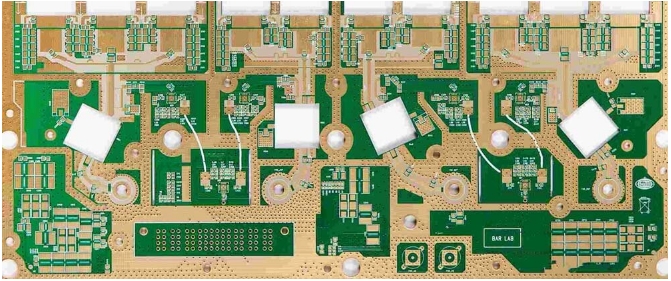Printed Circuit Boards (PCBs) are the backbone of modern electronic devices, and the choice of material for these boards is crucial for their performance and reliability. Among the various materials available, Rogers circuit board material stands out for its exceptional properties, especially in high-frequency applications. In this article, we will explore the benefits, applications, and key characteristics of Rogers PCB material, and why it is a preferred choice for many PCB designs.

Rogers Corporation is a well-known manufacturer of high-performance PCB materials. Rogers circuit board material is specifically designed for applications requiring high frequency and superior electrical properties. Unlike standard FR-4 material, which is commonly used in PCB manufacturing, Rogers materials offer a higher dielectric constant (Dk) and lower dielectric loss, making them ideal for high-frequency laminate applications.
Rogers PCB material is known for its high thermal conductivity, which is essential for effective thermal management in electronic devices. This property helps in dissipating heat efficiently, preventing overheating and ensuring the longevity of the components.
The dielectric constant (Dk) of Rogers material is stable across a wide range of frequencies. This stability is crucial for maintaining signal integrity and minimizing signal loss, making it an excellent choice for high-frequency applications.
Rogers materials exhibit low dielectric loss, which means they can efficiently transmit signals with minimal energy loss. This property is particularly important in high-frequency designs where signal integrity is paramount.
The coefficient of thermal expansion (CTE) of Rogers PCB material is closely matched to that of copper, which is commonly used in PCB fabrication. This matching reduces the risk of delamination and improves the reliability of the PCB under thermal cycling conditions.
Rogers materials are specifically engineered to provide superior high-frequency properties. They offer a low dissipation factor, which is essential for minimizing signal loss and maintaining the performance of high-frequency circuits.
Rogers PCB material offers superior electrical properties compared to standard FR-4 material. This includes a stable dielectric constant and low dielectric loss, which are critical for high-frequency and high-speed applications.
The high thermal conductivity of Rogers material ensures effective thermal management, which is crucial for preventing overheating and maintaining the performance of electronic components.
The matched CTE of Rogers material and copper reduces the risk of delamination and improves the overall reliability and durability of the PCB. This is particularly important in applications that undergo frequent thermal cycling.
Due to its superior electrical and thermal properties, Rogers PCB material is used in a wide range of applications, including telecommunications, aerospace, defense, and high-speed digital circuits.
While Rogers PCB material offers numerous advantages, it is generally more expensive than standard FR-4 material. However, for applications requiring high-frequency properties and superior performance, the investment in Rogers material is often justified. Designers must weigh the benefits against the cost to achieve an effective balance between cost and performance.
In telecommunications, high-frequency signals are common, and maintaining signal integrity is critical. Rogers PCB material is widely used in this industry due to its low dielectric loss and stable dielectric constant.
Aerospace and defense applications often require PCBs that can withstand harsh environments and high-frequency signals. The reliability and durability of Rogers material make it an ideal choice for these applications.
High-speed digital circuits require materials that can handle fast signal transitions with minimal signal loss. Rogers PCB material provides the necessary electrical properties to support these high-speed applications.
Medical devices often require precise and reliable electronic components. The superior electrical properties of Rogers material ensure that these devices function accurately and reliably.
Rogers PCB material offers superior electrical properties, including a stable dielectric constant and low dielectric loss, which are crucial for high-frequency and high-speed applications. Additionally, it provides better thermal management and reliability compared to standard FR-4 material.
High thermal conductivity helps in efficiently dissipating heat, preventing overheating, and ensuring the longevity of electronic components. This is particularly important in high-power and high-frequency applications where heat management is critical.
Rogers PCB material is engineered to have a stable dielectric constant (Dk) and low dielectric loss, which are essential for maintaining signal integrity and minimizing signal loss in high-frequency applications.
Yes, Rogers PCB material is generally more expensive than standard FR-4 material. However, its superior performance and reliability in high-frequency and high-speed applications often justify the higher cost.
Yes, Rogers PCB material is designed to withstand harsh environments, making it suitable for applications in aerospace, defense, and other industries where reliability and durability are critical.
Rogers PCB material is commonly used in telecommunications, aerospace, defense, high-speed digital circuits, and medical devices due to its superior electrical and thermal properties.
The CTE of Rogers material is closely matched to that of copper, reducing the risk of delamination and improving the overall reliability and durability of the PCB, especially under thermal cycling conditions.
Key electrical properties of Rogers PCB material include a stable dielectric constant (Dk), low dielectric loss, and low dissipation factor, all of which are essential for maintaining signal integrity and minimizing signal loss in high-frequency applications.
Rogers circuit board material is a premium choice for applications requiring high-frequency properties, superior electrical performance, and effective thermal management. While it may come at a higher cost compared to standard FR-4 material, the benefits it offers in terms of reliability, durability, and performance make it a worthwhile investment for many high-frequency and high-speed applications.
Designers and engineers looking to achieve an effective balance between cost and performance should consider Rogers PCB material for their next project. Its wide range of applications and superior properties make it a standard for PCB substrates in demanding environments.
By understanding the key characteristics and advantages of Rogers PCB material, you can make informed decisions in your PCB design and manufacturing process, ensuring optimal performance and reliability for your electronic devices.